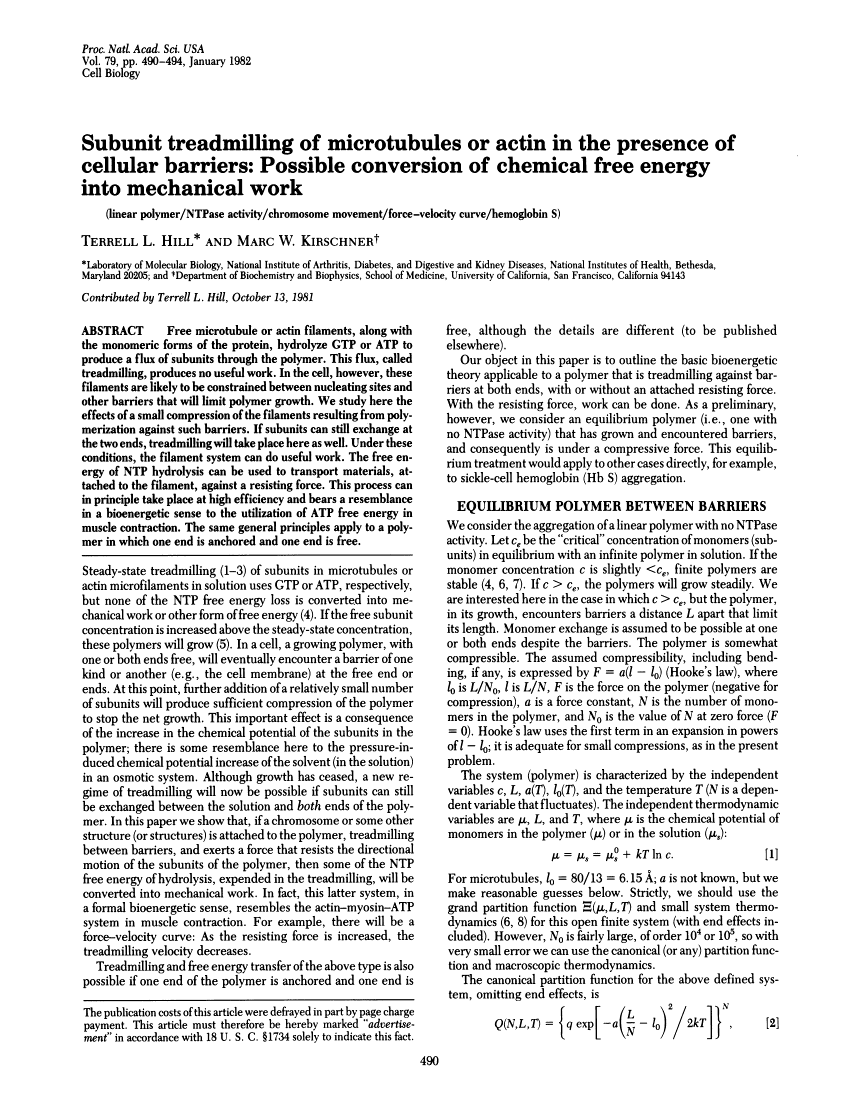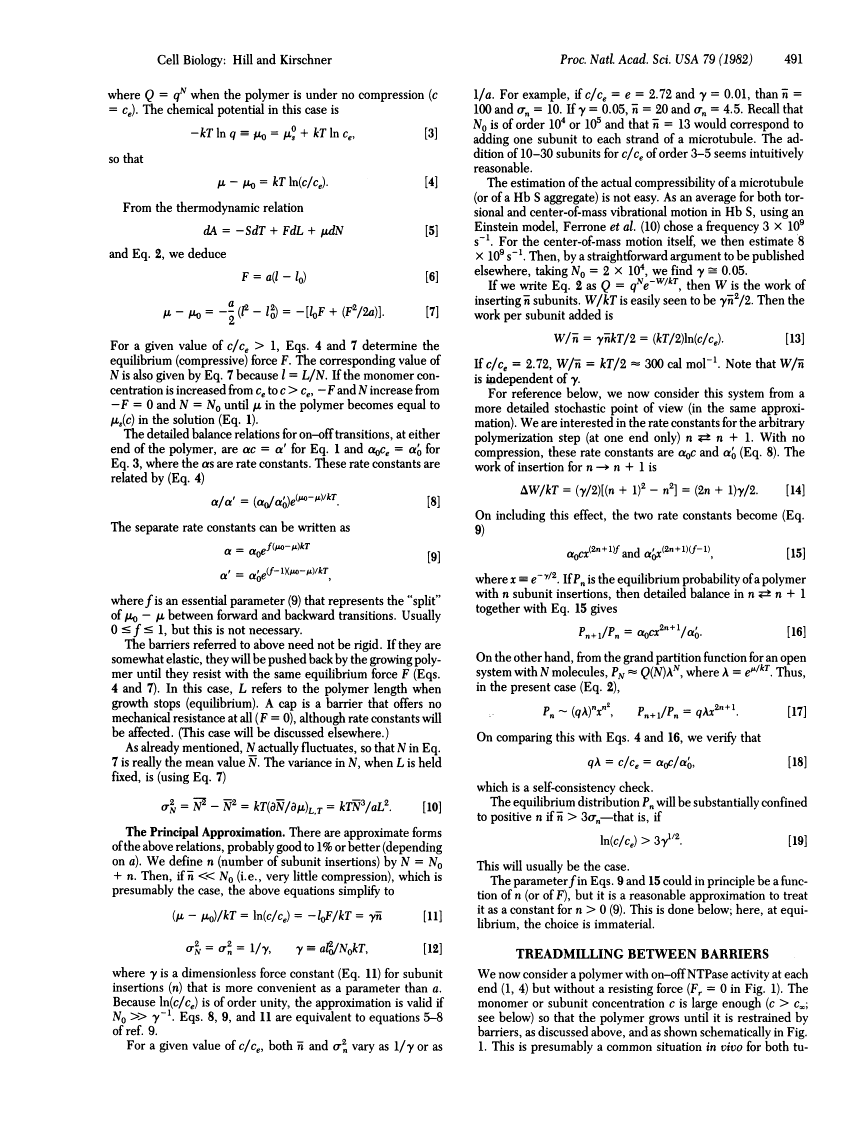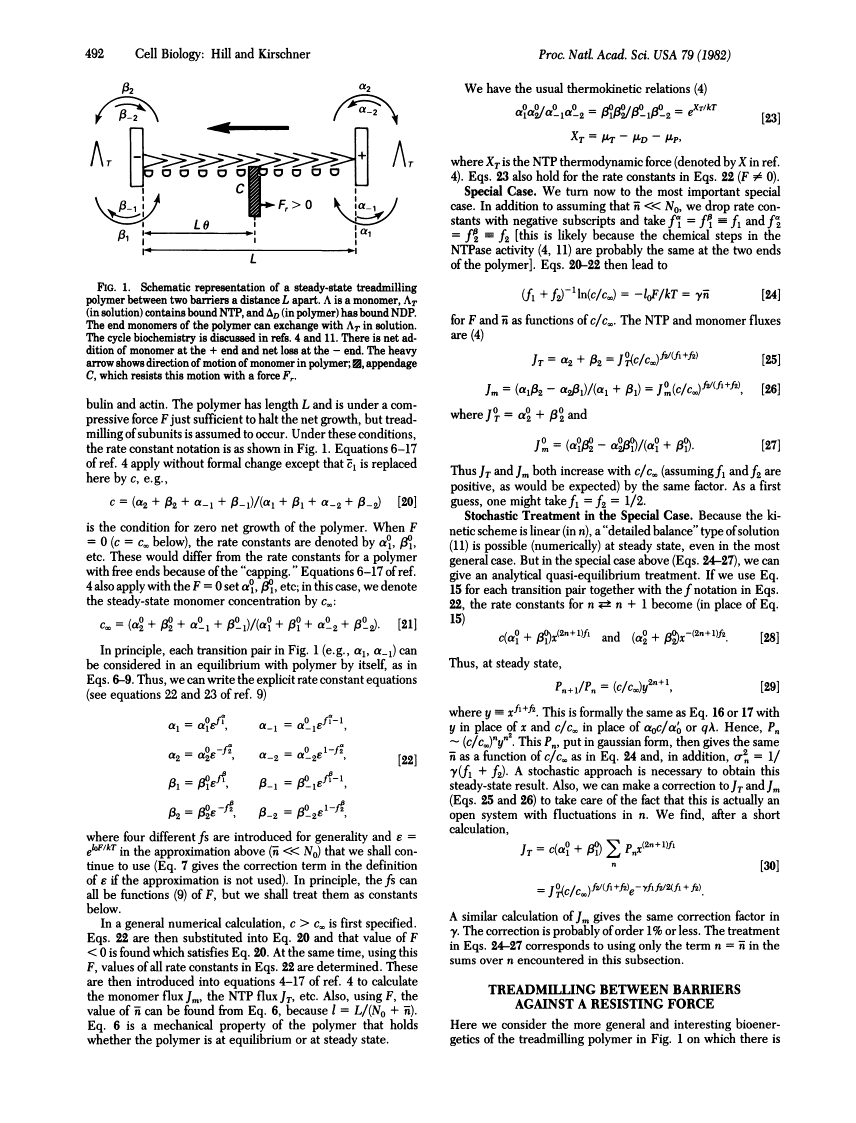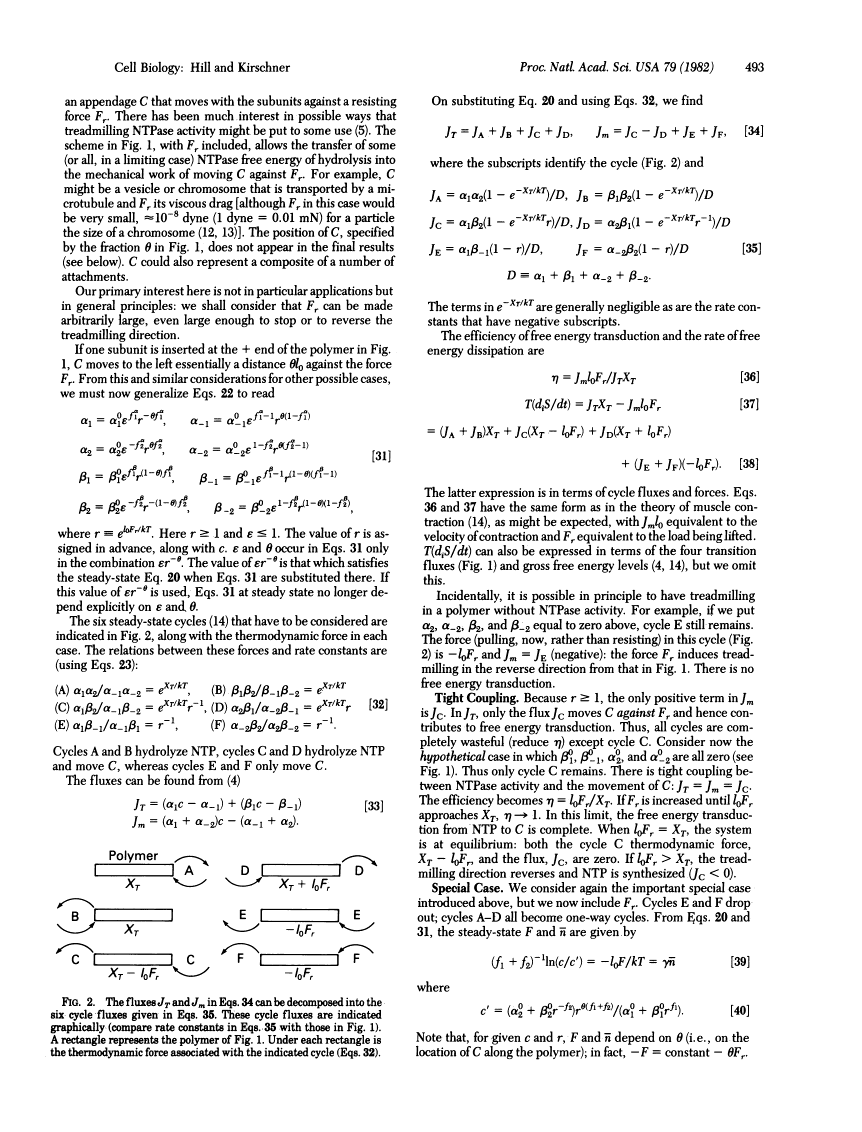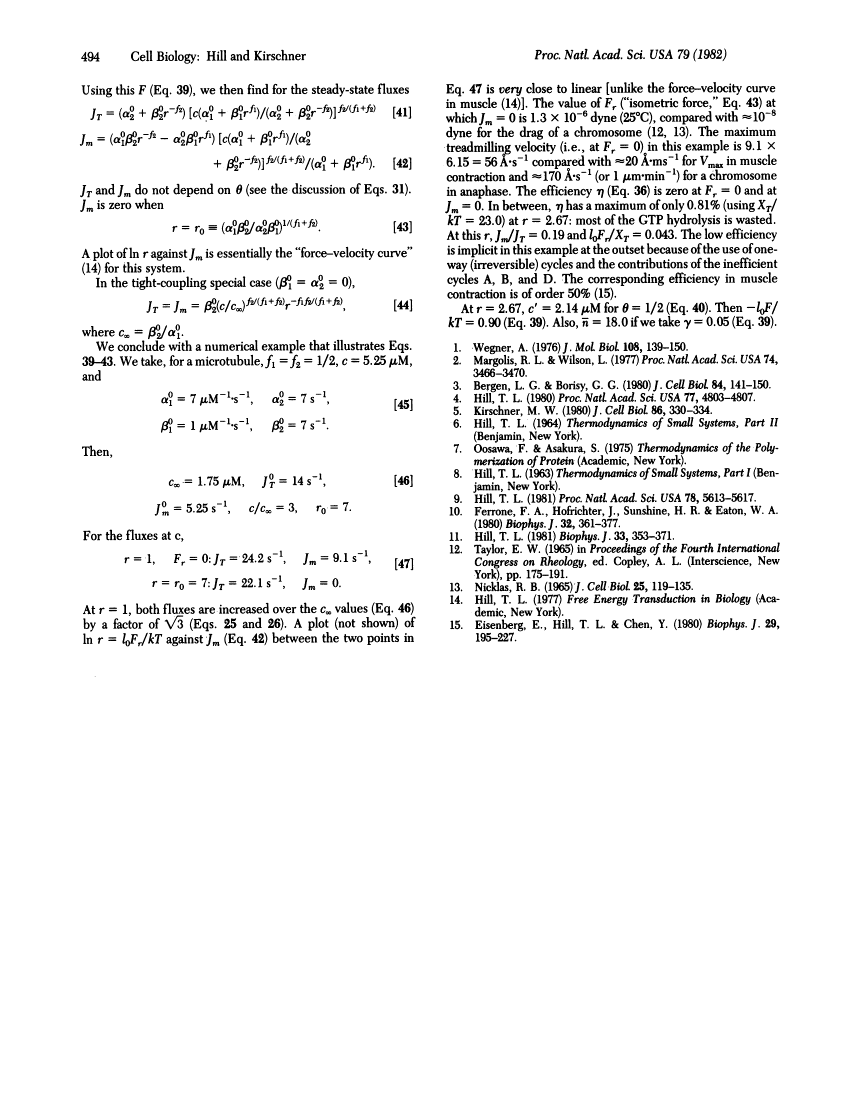Abstract
Free full text

Subunit treadmilling of microtubules or actin in the presence of cellular barriers: possible conversion of chemical free energy into mechanical work.
Abstract
Free microtubule or actin filaments, along with the monomeric forms of the protein, hydrolyze GTP or ATP to produce a flux of subunits through the polymer. This flux, called treadmilling, produces no useful work. In the cell, however, these filaments are likely to be constrained between nucleating sites and other barriers that will limit polymer growth. We study here the effects of a small compression of the filaments resulting from polymerization against such barriers. If subunits can still exchange at the two ends, treadmilling will take place here as well. Under these conditions, the filament system can do useful work. The free energy of NTP hydrolysis can be used to transport materials, attached to the filament, against a resisting force. This process can in principle take place at high efficiency and bears a resemblance in a bioenergetic sense to the utilization of ATP free energy in muscle contraction. The same general principles apply to a polymer in which one end is anchored and one end is free.
Full text
Full text is available as a scanned copy of the original print version. Get a printable copy (PDF file) of the complete article (885K), or click on a page image below to browse page by page. Links to PubMed are also available for Selected References.
Selected References
These references are in PubMed. This may not be the complete list of references from this article.
- Wegner A. Head to tail polymerization of actin. J Mol Biol. 1976 Nov;108(1):139–150. [Abstract] [Google Scholar]
- Margolis RL, Wilson L. Addition of colchicine--tubulin complex to microtubule ends: the mechanism of substoichiometric colchicine poisoning. Proc Natl Acad Sci U S A. 1977 Aug;74(8):3466–3470. [Europe PMC free article] [Abstract] [Google Scholar]
- Bergen LG, Borisy GG. Head-to-tail polymerization of microtubules in vitro. Electron microscope analysis of seeded assembly. J Cell Biol. 1980 Jan;84(1):141–150. [Europe PMC free article] [Abstract] [Google Scholar]
- Hill TL. Bioenergetic aspects and polymer length distribution in steady-state head-to-tail polymerization of actin or microtubules. Proc Natl Acad Sci U S A. 1980 Aug;77(8):4803–4807. [Europe PMC free article] [Abstract] [Google Scholar]
- Kirschner MW. Implications of treadmilling for the stability and polarity of actin and tubulin polymers in vivo. J Cell Biol. 1980 Jul;86(1):330–334. [Europe PMC free article] [Abstract] [Google Scholar]
- Hill TL. Microfilament or microtubule assembly or disassembly against a force. Proc Natl Acad Sci U S A. 1981 Sep;78(9):5613–5617. [Europe PMC free article] [Abstract] [Google Scholar]
- Ferrone FA, Hofrichter J, Sunshine HR, Eaton WA. Kinetic studies on photolysis-induced gelation of sickle cell hemoglobin suggest a new mechanism. Biophys J. 1980 Oct;32(1):361–380. [Europe PMC free article] [Abstract] [Google Scholar]
- Hill TL. Steady-state head-to-tail polymerization of actin or microtubules. II. Two-state and three-state kinetic cycles. Biophys J. 1981 Mar;33(3):353–371. [Europe PMC free article] [Abstract] [Google Scholar]
- NICKLAS RB. CHROMOSOME VELOCITY DURING MITOSIS AS A FUNCTION OF CHROMOSOME SIZE AND POSITION. J Cell Biol. 1965 Apr;25:SUPPL–SUPPL:135. [Europe PMC free article] [Abstract] [Google Scholar]
- Eisenberg E, Hill TL, Chen Y. Cross-bridge model of muscle contraction. Quantitative analysis. Biophys J. 1980 Feb;29(2):195–227. [Europe PMC free article] [Abstract] [Google Scholar]
Associated Data
Articles from Proceedings of the National Academy of Sciences of the United States of America are provided here courtesy of National Academy of Sciences
Full text links
Read article at publisher's site: https://doi.org/10.1073/pnas.79.2.490
Read article for free, from open access legal sources, via Unpaywall:
https://europepmc.org/articles/pmc345769?pdf=render
Citations & impact
Impact metrics
Citations of article over time
Smart citations by scite.ai
Explore citation contexts and check if this article has been
supported or disputed.
https://scite.ai/reports/10.1073/pnas.79.2.490
Article citations
Protrusion growth driven by myosin-generated force.
Dev Cell, 58(1):18-33.e6, 01 Jan 2023
Cited by: 11 articles | PMID: 36626869 | PMCID: PMC9940483
The molecular mechanism of load adaptation by branched actin networks.
Elife, 11:e73145, 24 Jun 2022
Cited by: 16 articles | PMID: 35748355 | PMCID: PMC9328761
Elasticity of podosome actin networks produces nanonewton protrusive forces.
Nat Commun, 13(1):3842, 04 Jul 2022
Cited by: 12 articles | PMID: 35789161 | PMCID: PMC9253342
Microfilaments and microtubules alternately coordinate the multi-step endosomal trafficking of Classical Swine Fever Virus.
J Virol, 95(10):JVI.02436-20, 24 Feb 2021
Cited by: 13 articles | PMID: 33627389 | PMCID: PMC8139654
Patterning and polarization of cells by intracellular flows.
Curr Opin Cell Biol, 62:123-134, 21 Nov 2019
Cited by: 24 articles | PMID: 31760155 | PMCID: PMC6968950
Review Free full text in Europe PMC
Go to all (41) article citations
Similar Articles
To arrive at the top five similar articles we use a word-weighted algorithm to compare words from the Title and Abstract of each citation.
Implications of treadmilling for the stability and polarity of actin and tubulin polymers in vivo.
J Cell Biol, 86(1):330-334, 01 Jul 1980
Cited by: 118 articles | PMID: 6893454 | PMCID: PMC2110666
How profilin/barbed-end synergy controls actin polymerization: a kinetic model of the ATP hydrolysis circuit.
Cell Motil Cytoskeleton, 35(4):309-330, 01 Jan 1996
Cited by: 12 articles | PMID: 8956003
Bacterial Tubulins A and B Exhibit Polarized Growth, Mixed-Polarity Bundling, and Destabilization by GTP Hydrolysis.
J Bacteriol, 199(19):e00211-17, 05 Sep 2017
Cited by: 8 articles | PMID: 28716960 | PMCID: PMC5585714
Microtubule treadmills--possible molecular machinery.
Nature, 293(5835):705-711, 01 Oct 1981
Cited by: 150 articles | PMID: 7027052
Review
